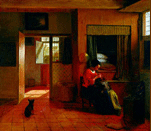










Elizabeth V. Chew
Associate Curator of Collections
Monticello
Monticello, Thomas Jefferson’s neoclassical plantation house near Charlottesville, Virginia, like most contemporary plantation great houses in eighteenth and early nineteenth-century America, was a physical space dominated and kept running by women, both black and white, enslaved and free. Nevertheless, Monticello is today and always has been almost exclusively associated with the founding father who designed it and directed its construction over a forty year period between 1769 and 1809. Except for two-century old debates about Sally Hemings, Jefferson’s slave who bore four children almost certainly fathered by him, no female names are readily associated with Jefferson’s famous house.
This paper will address the spatial position of women at Monticello. It has become a commonplace in feminist architectural history that, in the words of Alice Friedman, “architecture constructs and controls gender relationships” and “stages the value systems of a culture, foregrounding certain activities and persons and obscuring others.” In Jefferson’s retirement, from 1809 when he completed his second term as president until his death in 1826, Monticello was also the home of his eldest daughter and only surviving child, Martha Jefferson Randolph, and her eleven children, six of whom were girls. In 1809 the granddaughters ranged in age from six to eighteen. During this same time Monticello was also the home of approximately 55 female slaves, both adults and children. The adult women worked as cooks, domestic servants, ladies’ maids, nursemaids, farm laborers, spinners, and midwives; they ran the dairy, laundry, and smoke house. Enslaved girls between the ages of ten and sixteen worked as weavers and eight to ten year old girls cared for younger enslaved children.
Visitors to Monticello today see the main and basement floors of the house. Priority is still given to the main floor, where groups of visitors circulate in the company of interpreters. Jefferson’s private suite of rooms occupies approximately a third of that space; much of the rest is taken up with public rooms for reception, entertainment, and dining filled with objects that reflect his interests and preoccupations. This paper will re-situate women within this environment. Using rich primary sources including architectural drawings, family letters, and Jefferson’s records of the enslaved community, it will consider architecturally and spatially how women’s subjectivities shaped and were shaped by the famous house of a famous man.
|
|
|
||||||
|
|
 |
 |
|
||||
 |
|
 |
|
||||
|
|
|
||||||
|
|
|
||||||
 |
|
||||||
|
|
|
||||||
| |
|
||||||
 |
|
||||||
 |
|
||||||
 |
|
||||||
 |
|
||||||
|
|
|
||||||
|
|
 |
|
|
||||
 |
|
||||||
|
|
|
|
|
|
|
|
|